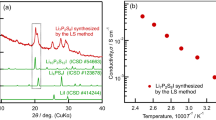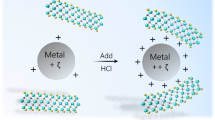Abstract
Sodium zirconium phosphate (labeled as NZP)-monazite-type (1-x)Sr0.5Zr2(PO4)3–xCePO4 (x = 0–1.0) composite ceramics, which were designed to simultaneously immobilize simulated fission nuclide Sr and variable valence actinide nuclide Ce, were in situ prepared by one-step microwave sintering technique. The feasibility of Sr/Ce co-immobilization was evaluated via an investigation on the phase evolution, microstructure, density, Vickers hardness, and chemical stability of the composite ceramics. The Ce valence state in the composite ceramics was further ascertained by X-ray photoelectron spectroscopy. It was shown that the Sr/Ce co-immobilized composite ceramics only consisted of Sr0.5Zr2(PO4)3 and CePO4 crystalline phases that were compatible well to each other. Sr and Ce were independently incorporated into Sr0.5Zr2(PO4)3 phase and CePO4 phase, respectively. The valence state of Ce in composite ceramics existed in trivalent state. And the existence of CePO4 phase caused the grain refinement and facilitated the densification of the composite ceramics. The composite samples all showed a highly uniform and dense microstructure, whose relative density was higher than 95% and Vickers hardness could attain 774 HV1. Importantly, the series of Sr0.5Zr2(PO4)3–CePO4 composite ceramics exhibited higher chemical stability than that of the monophase Sr0.5Zr2(PO4)3 or CePO4 ceramics, in which the normalized leaching rates of Sr and Ce were below 10−4 g·m−2·day−1 and 10−7 g·m−2·day−1 order of magnitude, respectively. The NZP-monazite-type composite ceramics has the potential to be a host for the disposal of high-level nuclear wastes containing multiple radionuclides.






Similar content being viewed by others
References
Ewing, R.C.: Radiation effects in nuclear waste forms for high-level radioactive waste. Prog. Nucl. Energ. 29, 63–127 (1995)
Donald, I.W.: Waste immobilization in glass and ceramic based hosts: radioactive, toxic and hazardous wastes. Tetrahedron Lett. 38, 4199–4202 (2010)
Wei, Y.F., Luo, P., Wang, J.X., Wen, J.W., Zhan, L., Zhang, X., Yang, S.Y., Wang, J.: Microwave-sintering preparation, phase evolution and chemical stability of Na1-2xSrxZr2(PO4)3 ceramics for immobilizing simulated radionuclides. J. Nucl. Mater. 540, 152366 (2020)
Bohre, A., Shrivastava, O.: Crystallographic evaluation of sodium zirconium phosphate as a host structure for immobilization of cesium and strontium. Int. J. Appl. Ceram. Tec. 10, 552–563 (2013)
Bykov, D.M., Gobechiya, E.R., Kabalov, Y.K., Orlova, A.I., Tomilin, S.V.: Crystal structures of lanthanide and zirconium phosphates with general general formula Ln0.33Zr2(PO4)3, where Ln=Ce, Eu, Yb. J. Solid. State Chem. 179, 3101–3106 (2006)
Potanina, E., Golovkina, L., Orlova, A., Nokhrin, A., Boldin, M., Sakharov, N.: Lanthanide (Nd, Gd) compounds with garnet and monazite structures. Powders synthesis by “wet” chemistry to sintering ceramics by Spark Plasma Sintering. J. Nucl. Mater. 473, 93–98 (2016)
Rawat, D., Phapale, S., Mishra, R., Dash, S.: Thermodynamic investigation of thorium and strontium substituted monazite solid-solution. Thermochim. Acta 674, 10–20 (2019)
Zhang, Y.T., Huang, Z.Y., Qi, J.Q., Han, Y., Tang, Z., Wei, H., Duan, J.J., Zeng, Y.Y., Zhang, H.B., Lu, T.C.: Rapid fabrication of fine-grained Gd2-xNdxZr2-5xCe5xO7 ceramics by microwave sintering. J. Alloys. Compounds 781, 710–715 (2019)
Helean, K.B., Navrotsky, A., Lian, J., Ewing, R.C.: Thermochemical investigations of zirconolite, pyrochlore and brannerite: candidate materials for the immobilization of plutonium. MRS Proc. 807, 297 (2003)
Chartier, A., Meis, C., Gale, J.D.: Computational study of Cs immobilization in the apatites Ca10(PO4)6F2, Ca4La6(SiO4)6F2 and Ca2La8(SiO4)6O2. Phys. Rev. B 64, 085110 (2001)
Amoroso, J., Marra, J.C., Tang, M., Lin, Y., Chen, F., Su, D., Brinkman, K.S.: Melt processed multiphase ceramic waste forms for nuclear waste immobilization. J. Nucl. Mater. 454, 12–21 (2014)
Clark, B.M., Tumurgoti, P., Sundaram, S.K., Amoroso, J.W., Marra, J.C., Shutthanandan, V., Tang, M.: Radiation damage of hollandite in multiphase ceramic waste forms. J. Nucl. Mater. 494, 61–66 (2017)
Harkins, D.H.: The durability of single, dual, and multiphase titanate ceramic waste forms for nuclear waste immobilization, Masters Thesis, Clemson University, Clemson, SC (2016)
Clark, B.M., Tumurgoti, P., Sundaram, S.K., Amoroso, J.W., Marra, J.C.: Preparation and characterization of multiphase ceramic designer waste forms. Sci. Rep. 11, 4512 (2021)
Ma, J., Fang, Z.W., Yang, X.Y., Wang, B., Luo, F., Zhao, X.L., Wang, X.F., Yang, Y.S.: Investigating hollandite-perovskite composite ceramics as a potential waste form for immobilization of radioactive cesium and strontium. J. Mater. Sci. 56, 9644–9654 (2021)
Teng, Y.C., Wang, S.L., Wu, L., Gui, C.M.: Synthesis and hydrothermal stability of U doped zirconolite–sphene composite materials. Adv. Appl. Ceram. 114, 9–13 (2015)
Ding, Y., Jiang, Z.D., Xiong, T.H., Bai, Z.M., Zhao, D.D., Dan, H., Duan, T.: Phase and microstructure evolution of 0.2Zr1-xCexO2/Zr1-yCeySiO4 (0≤x+y≤1) ceramics designed to immobilize tetravalent actinides. J. Nucl. Mater. 539, 152318 (2020)
Teng, Y.C., Wang, Q., Wu, L., Zhao, X.F., Chen, Y., Cao, X., Wang, W.: Effect of reactivity of silicon and magnesium on the preparation of SiC-MgAl2O4 composites for immobilizing graphite. Ceram. Int. 45, 10203–10210 (2019)
Wang, Q., Teng, Y.C., Wu, L., Zhang, K.B., Zhao, X.F., Hu, Z.: Synthesis and characterization of SiC based composite materials for immobilizing radioactive graphite. J. Nucl. Mater. 504, 94–100 (2018)
Wang, L., Liang, T.X.: Ceramics for high level radioactive waste solidification. J. Adv. Ceram. 1, 194–203 (2012)
Hagman, L., Kierkegaard, P., Karvonen, P., Virtanen, A.I., Paasivirta, J.: The crystal structure of NaMe2IV(PO4)3; MeIV= Ge, Ti. Zr. Acta Chem. Scand. 22, 1822–1832 (1968)
Mutter, D., Urban, D.F., Elsässer, C.: Computational analysis of composition- structure- property- relationships in NZP-type materials for Li-ion batteries. J. Appl. Phys. 125, 215115 (2019)
Wang, Y., Zhou, Y.Y., Han, Z.Q., Liu, F.T.: Investigation and characterization of crystal structure, mechanical and thermophysical properties of CaZr4-xTixP6O24 ceramics. Ceram. Int. 45, 10596–10602 (2019)
Hashimoto, C., Nakayama, S.: Immobilization of Cs and Sr to HZr2(PO4)3 using an autoclave. J. Nucl. Mater. 396, 197–201 (2010)
Pet’kov, V., Asabina, E., Loshkarev, V., Sukhanov, M.: Systematic investigation of the strontium zirconium phosphate ceramic form for nuclear waste immobilization. J. Nucl. Mater. 471, 122–128 (2016)
Gregg, D.J., Karatchevtseva, I., Thorogood, G.J., Davis, J., Bell, B.D.C., Jackson, M., Dayal, P., Ionescu, M., Triani, G., Short, K., Lumpkin, G.R., Vance, E.R.: Ion beam irradiation effects in strontium zirconium phosphate with NZP-structure type. J. Nucl. Mater. 446, 224–231 (2014)
Schlenz, H., Heuser, J., Neumann, A., Schmitz, S., Bosbach, D.: Monazite as a suitable actinide waste form,Z. Krist.-Cryst. Mater. 228, 113–123 (2013)
Ishida, M., Yanagi, Y., Terai, T.R.: Leach rates of composite waste forms of monazite- and zirconium phosphate-type. J. Nucl. Sci. Technol. 24, 404–408 (1987)
Orlova, A., Kitaev, D.: Phosphate monazite- and NaZr2(PO4)3 (NZP)-like ceramics containing uranium and plutonium. Czech. J. Phys. 53, 665–670 (2003)
Orlova, A.L., Ojovan, M.I.: Ceramic mineral waste-Forms for nuclear waste immobilization. Materials 12, 2638 (2019)
Yang, J., Wan, C.L., Zhao, M., Shahid, M., Pan, W.: Effective blocking of radiative thermal conductivity in La2Zr2O7/LaPO4 composites for high temperature thermal insulation applications. J. Eur. Ceram. Soc. 36, 3809–3814 (2016)
Sujith, S.S., Arun Kumar, S.L., Mahesh, K.V., Peer Mohamed, A., Ananthakumar, S.: Sintering and thermal shock resistance properties of LaPO4 based composite refractories. T. Indian Ceram. Soc. 73, 161–164 (2014)
Wang, J.X., Luo, P., Wang, J., Zhan, L., Wei, Y.F., Zhu, Y.M., Yang, S.Y., Zhang, K.B.: Microwave-sintering preparation and densification behavior of sodium zirconium phosphate ceramics with ZnO additive. Ceram. Int. 46, 3023–3027 (2019)
Zhan, L., Wang, J.X., Wang, J., Zhang, X., Wei, Y.F., Yang, S.Y.: Phase evolution and microstructure of new Sr0.5Zr2(PO4)3-NdPO4 composite ceramics prepared by one-step microwave sintering. Ceram. Int. 46, 19822–19826 (2020)
ASTM (American Society for Testing and Materials), Standard: C1285–14, standard test methods for determining chemical durability of nuclear, hazardous, and mixed waste glasses and multiphase glass ceramics: the product consistency test (PCT), ASTM International West, Conshohocken, PA, (2014)
Pratheep Kumar, S., Gopal, B.: Simulated monazite crystalline waste form La0.4Nd0.1Y0.1Gd0.1Sm0.1Ce0.1Ca0.1(P0.9Mo0.1O4): synthesis, phase stability and chemical durability study. J. Nucl. Mater. 458, 224–232 (2015)
Buvaneswari, G., Varadaraju, U.: Low leachability phosphate lattices for fixation of select metal ions. Mater. Res. Bull. 35, 1313–1323 (2000)
Rygel, J.L., Pantano, C.G.: Synthesis and properties of cerium aluminosilicophosphate glasses. J. Non Cryst. Solids 355, 2622–2629 (2009)
Funding
This work was financially supported by the National Natural Science Foundation of China (Nos. 11705153 and 12075195).
Author information
Authors and Affiliations
Corresponding authors
Ethics declarations
Conflict of interest
The authors declare no competing interests.
Additional information
Publisher's note
Springer Nature remains neutral with regard to jurisdictional claims in published maps and institutional affiliations.
Rights and permissions
About this article
Cite this article
Wang, J., Zhan, L., Wang, J. et al. Sr/Ce co-immobilization evaluation and high chemical stability of novel Sr0.5Zr2(PO4)3–CePO4 composite ceramics for nuclear waste forms. J Aust Ceram Soc 58, 881–889 (2022). https://doi.org/10.1007/s41779-022-00736-z
Received:
Revised:
Accepted:
Published:
Issue Date:
DOI: https://doi.org/10.1007/s41779-022-00736-z




